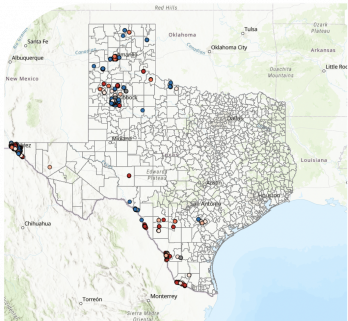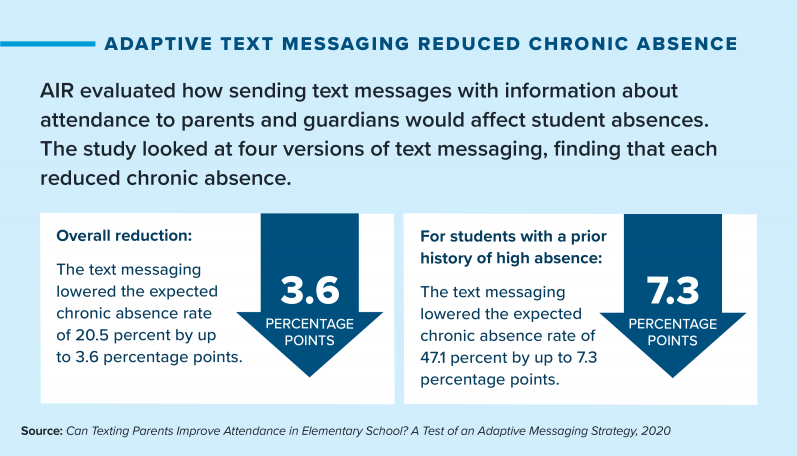How to Tackle Chronic Absenteeism: Resources for Policymakers, Educators, and Researchers

If your local district is interested in participating, please email our team.
Helping young people succeed in the classroom at a time when so many students are missing school presents a significant national challenge for educators and local leaders. According to a recent White House fact sheet, rates of chronic absenteeism, identified as students who miss at least 10 percent of school, reached 31 percent during the 2021-2022 school year. Chronically absent students are much less likely to read at grade level and to graduate from high school. Getting more kids into the classroom could, ultimately, have positive effects on college enrollment and educational attainment.
Schools, districts, and teachers need support and evidence-based solutions to help students who are chronically absent. AIR experts have studied the effectiveness of strategies and programs designed to mitigate chronic absenteeism and increase student engagement. Our experts also have worked with partners at the U.S. Department of Education and groups such as AttendanceWorks, to generate and share tools and resources that align with the 2024 Agenda to Improve Student Achievement.
Explore Chronic Absenteeism Data Across the U.S.

Chronic absenteeism varies across states and among the schools and districts within states. AIR developed the COVID-19 and Equity in Education Chronic Absenteeism Explorer, a new interactive data tool that allows policymakers and educators to analyze pre- and post-pandemic student chronic absenteeism trends. Data are available at the state, district and school levels, as well as sortable by a range of school, community, and student characteristics.
Here are four ways education leaders can harness evidence to address attendance:
1. Strengthen positive communication with families.
Research shows that increasing effective communication with families, through positive text messaging, email and telephone calls, can help improve rates of attendance among students.
For example, one AIR study found that a text messaging strategy that started with basic messages, and then “adapted” to provide additional intensified messaging for families whose children had more absences, could improve attendance.

2. Improve student engagement and conditions for learning.
The ways students, families, teachers, and other school staff experience school affects student attendance, learning, and achievement. Research shows, for example, that there is less widespread chronic absence at schools where educators create and maintain a safe, supportive, culturally responsive, and engaging environment for learning.
Students who get to experience learning environments that are safe, supportive, and engaging are more likely to improve academically, participate more fully in the classroom, and develop skills that will help them be successful in school and in life. They also are less likely to participate in disruptive behavior, have issues with attendance like absenteeism and truancy, drop out, be suspended, display aggressive behavior, and engage in violence. View more AIR resources on conditions for learning.
3. Invest in early warning systems.
More states, districts, and schools are using research-based indicators to identify students displaying symptoms of risk of failing to meet key educational milestones, such as reading at grade level, on-time graduation, and college readiness and college persistence. By identifying these students early, educators can target interventions and supports to help students achieve success.
AIR led one of the first studies to evaluate the effectiveness of an early warning system process in schools—the Early Warning Intervention and Monitoring System (EWIMS)—finding it to be a promising strategy to reduce the percentage of students with chronic absences and course failures. To help schools and districts establish and implement EWIMS processes and help students succeed, our experts created Implementation Guides for High School and Middle Grades. View more AIR resources on early warning systems.

4. Engage strength-based, community-focused supports and services.
Many public schools provide services and support that are connected across communities and neighborhoods. Often these services and supports are developed, implemented, and maintained by families, communities, and educators all working together to help students succeed and address areas where there are higher rates of chronic absenteeism.
One approach, known as Building Assets and Reducing Risks (BARR) is a comprehensive, strengths-based approach to education that aims to boost achievement for all students by improving a school’s effectiveness at building relationships, leveraging real-time student data, and capitalizing on the strengths of each student. Recent evidence has shown that BARR significantly reduced rates of chronic absenteeism within the schools where it was implemented. View more AIR resources on community-focused supports.
More AIR Resources on Chronic Absenteeism
Conditions for Learning

In Less is More: The Effects of Suspension and Suspension Severity on Behavioral and Academic Outcomes, AIR researchers report their findings from working with the New York City Department of Education to investigate the effects of the type and length of suspension on students. Among the findings: Receiving more severe exclusionary disciplinary responses increases the number of days students miss due to absence during subsequent school years.
The National Center on Safe Supportive Learning Environments, operated by AIR, offers a wide range of resources focused on improving school climate and conditions for learning so that all students have the opportunity to realize academic success, including these webinars:
- Creating Welcoming School Environments shares research on health behaviors and experiences among adolescents—and the positive effects of connectedness and belonging on students’ health and well-being.
- Strategies for Supporting Full Student Participation explores why students disengage and key strategies to support all students in meaningfully participating in school.
Early Warning Systems

AIR is part of the GRAD Partnership for Student Success, which expands early warning systems to include more holistic data, such as school climate, student belonging and student connectedness, positive supportive relationships, and student-centered mindsets. A tool AIR created through GRAD Partnership discusses how multi-tiered systems of support and early warning systems can be organized as one unified system through student success systems.
With support from AIR, the Student Engagement and Attendance Center (SEAC) supports state education agencies and local education agencies in their efforts to reduce chronic absenteeism and increase student engagement. SEAC’s Action Planner for Reengaging Students to Support Everyday Attendance tool provides school communities with a process for 1) collaboratively assessing the root causes of students’ disengagement and unenrollment, and 2) collectively developing reengagement strategies and interventions for their students.
Community-focused Supports
Community schools are a strategy to support students, their families, and the broader school community. Our Spotlight on Community Schools Work shows how AIR uses the strongest research evidence and deep technical assistance expertise to support multiple community schools initiatives in achieving their goals.

The longitudinal Research on Lowering Violence in Communities and Schools (ReSOLV) study examined the association of school safety and student outcomes, including absenteeism, with school-based risk and protective factors and readiness to adopt a comprehensive school safety approach.
In Harnessing the Power of Afterschool and Summer Programs to Support Recovery and Reengagement, AIR researchers offer a potential pathway to understanding how learning and development happen in quality afterschool and summer programs. Studies of afterschool and summer programs have demonstrated a number of positive outcomes, including improved school-day attendance and fewer unexcused absences.
Policy Resources
The Equitable Attendance Policy Partnership (EAPP) aims to support states interested in examining and improving attendance policies and approaches, particularly for students and families with lived experience of the truancy process.
Attendance Legislation in the United States summarizes the findings of a scan AIR conducted of attendance policies throughout the United States, including a review of policy reforms and the effects of those reforms.


